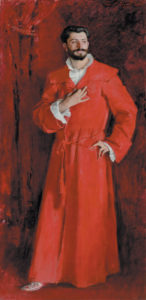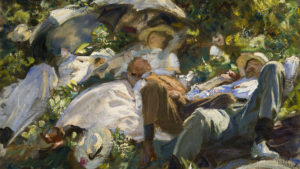There are no paintings by John Singer Sargent in the Museum of Modern Art, although he was of the same generation as the impressionist and postimpressionist painters. Nor are there any at the Whitney Museum of American Art, which has its own modernist narrative that begins with the so-called ashcan school.

For Sargent, an expatriate, fashionable portrait painter in Europe and America, was as far from gritty ashcan aesthetics as he was from radical modernist experimentation. He was closer to old masters like Velazquez and Frans Hals than to contemporaries like Van Gogh or John Sloan. This has sometimes made him a problematic figure for scholars and art historians. He was a wizard with the brush, they concede, but it was all on the surface. He was superficial.
Meanwhile, he’s still a surefire hit with museum audiences. What to do?
Now a show at the Metropolitan Museum takes a stab at resolving the problem. “Sargent: Portraits of Artists and Friends,” presents a new, deeper Sargent. Instead of his bread-and-butter portraits of rich women and their children, it gives us the paintings he made of the people close to him and the artists he admired.
In the process, it gives Sargent an inner life rich in the ideas and artistic movements of his day. He still looks like a stiff in his self-portraits, but he gets looser in the paintings of his friends, which included volcanic artists like Auguste Rodin, avant-garde composer Gabriel Faure, brainy novelists like Henry James and bohemian actors and actresses. Call it virtue by association. Well, virtue may not be the right word.

John Singer Sargent: Dr. Pozzi at Home, 1881
Consider Dr. Samuel-Jean Pozzi, a charismatic gynecological surgeon, who Sargent chose to paint in a startling crimson robe that looks half Catholic cardinal and half Hugh Hefner. The pose spotlights his elegant surgeon’s hands, but this is a boudoir portrait of a man famous for his love affairs, including one with the actress Sarah Bernhardt. He also founded something called the League of the Rose, a group where people confessed, then acted out sexual fantasies. Who knew?
Sargent has fun in his portrait of author Robert Louis Stevenson, showing the lanky, long-haired author tugging at his droopy moustache while wandering off to the left edge of the painting. The composition leaves wife Fanny – dressed in some exotic garb as a joke — almost falling out of the right side of the picture. Stevenson liked the portrait but concluded that “it looks damn queer as a whole.”
Sargent was unquestionably a careerist. Being a successful portrait painter required a lot of networking and Sargent, who was born in Florence and spoke four languages, was as charming and as cosmopolitan as they come. He made once serious blunder, however: His edgy portrait of the sensuous, predatory society hostess, “Madame X,” caused a scandal that compelled Sargent to leave Paris society for London. He continued to call it his best painting, however, and there are strange echoes of it in his portrait of art patron Isabella Stewart Gardner. He paints her in a black dress that similarly echoes her feminine curves. But Gardner was no femme fatale and there’s something vaguely hostile in the awkwardness of her forward-leaning pose and in the rendering of her indistinct features which Sargent cuttingly referred to as “a lemon with a slit for a mouth.”
There are two paintings here of Claude Monet, who, like Sargent, was a virtuoso with the brush. In one, Sargent paints him outdoors at work on a canvas. There is something of Monet’s method in the picture, but Sargent, if he tried, never got the hang of impressionism, which was all about perception and the effects of light.
But painting en plein air was in vogue in the late 19th century, and this show is well-stocked with Sargent’s paintings of young Edwardian artists outdoors with straw hats, parasols and painting equipment (replicas of which are for sale in the show’s gift shop). Once you get past the absence of impressionist sparkle and vibrancy in these quasi-impressionist pictures, you can enjoy them for what they evoke about the mood and spirit of those days. The women are newly emancipated, painting right next to the men or, in some cases, painting while the men watch passively.

In one picture, two couples have fallen asleep in the grass, all entangled, as if sprinkled with fairy dust. It’s hard to tell who is with who, and that, too, was a feature of life among Edwardian aesthetes. Not much is known about Sargent’s own sex life. He has usually been cast as a reticent bachelor. But in the interest of giving him color and depth, the curators have spotlighted his watercolors of nude soldiers and laborers as a way of indirectly making the case that he was gay.
All in all, the show is enlightening, introducing us to a Sargent who may not have been a modern painter, but who was very much a painter of modern life.

